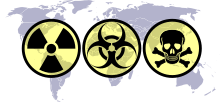Nuclear weapon
This article needs additional citations for verification. (May 2022) |
| Nuclear weapons |
|---|
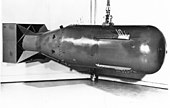 |
| Background |
| Nuclear-armed states |
|
A nuclear weapon[a] is an explosive device that derives its destructive force from nuclear reactions, either fission (fission bomb) or a combination of fission and fusion reactions (thermonuclear bomb), producing a nuclear explosion. Both bomb types release large quantities of energy from relatively small amounts of matter.
The
A nuclear device no larger than a
Testing and deployment
Nuclear weapons have only twice been used in warfare, both times by the
Since the atomic bombings of Hiroshima and Nagasaki, nuclear weapons have been detonated over 2,000 times for testing and demonstration. Only a few nations possess such weapons or are suspected of seeking them. The only countries known to have detonated nuclear weapons—and acknowledge possessing them—are (chronologically by date of first test) the United States, the Soviet Union (succeeded as a nuclear power by Russia), the United Kingdom, France, China, India, Pakistan, and North Korea. Israel is believed to possess nuclear weapons, though, in a policy of deliberate ambiguity, it does not acknowledge having them. Germany, Italy, Turkey, Belgium, the Netherlands, and Belarus are nuclear weapons sharing states.[5][6][b] South Africa is the only country to have independently developed and then renounced and dismantled its nuclear weapons.[7]
The Treaty on the Non-Proliferation of Nuclear Weapons aims to reduce the spread of nuclear weapons, but there are different views of its effectiveness.[8]
Types
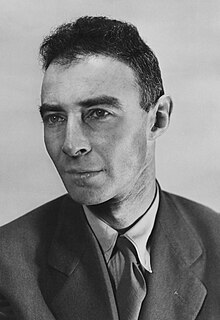
There are two basic types of nuclear weapons: those that derive the majority of their energy from nuclear fission reactions alone, and those that use fission reactions to begin nuclear fusion reactions that produce a large amount of the total energy output.[10]
Fission weapons
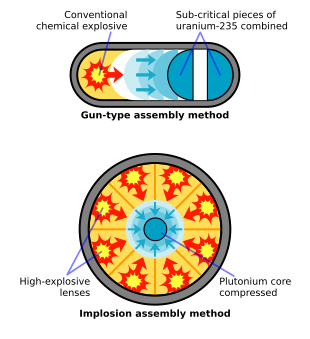
All existing nuclear weapons derive some of their explosive energy from nuclear fission reactions. Weapons whose explosive output is exclusively from fission reactions are commonly referred to as atomic bombs or atom bombs (abbreviated as A-bombs). This has long been noted as something of a misnomer, as their energy comes from the nucleus of the atom, just as it does with fusion weapons.
In fission weapons, a mass of fissile material (enriched uranium or plutonium) is forced into supercriticality—allowing an exponential growth of nuclear chain reactions—either by shooting one piece of sub-critical material into another (the "gun" method) or by compression of a sub-critical sphere or cylinder of fissile material using chemically fueled explosive lenses. The latter approach, the "implosion" method, is more sophisticated and more efficient (smaller, less massive, and requiring less of the expensive fissile fuel) than the former.
A major challenge in all nuclear weapon designs is to ensure that a significant fraction of the fuel is consumed before the weapon destroys itself. The amount of energy released by fission bombs can range from the equivalent of just under a ton to upwards of 500,000 tons (500
All fission reactions generate fission products, the remains of the split atomic nuclei. Many fission products are either highly radioactive (but short-lived) or moderately radioactive (but long-lived), and as such, they are a serious form of radioactive contamination. Fission products are the principal radioactive component of nuclear fallout. Another source of radioactivity is the burst of free neutrons produced by the weapon. When they collide with other nuclei in the surrounding material, the neutrons transmute those nuclei into other isotopes, altering their stability and making them radioactive.
The most commonly used fissile materials for nuclear weapons applications have been
Fusion weapons
The other basic type of nuclear weapon produces a large proportion of its energy in nuclear fusion reactions. Such fusion weapons are generally referred to as thermonuclear weapons or more colloquially as hydrogen bombs (abbreviated as H-bombs), as they rely on fusion reactions between isotopes of hydrogen (deuterium and tritium). All such weapons derive a significant portion of their energy from fission reactions used to "trigger" fusion reactions, and fusion reactions can themselves trigger additional fission reactions.[13]
Only six countries—the United States, Russia, the United Kingdom, China, France, and India—have conducted thermonuclear weapon tests. Whether India has detonated a "true" multi-staged thermonuclear weapon is controversial.[14] North Korea claims to have tested a fusion weapon as of January 2016[update], though this claim is disputed.[15] Thermonuclear weapons are considered much more difficult to successfully design and execute than primitive fission weapons. Almost all of the nuclear weapons deployed today use the thermonuclear design because it is more efficient.[16]
Thermonuclear bombs work by using the energy of a fission bomb to compress and heat fusion fuel. In the
Virtually all thermonuclear weapons deployed today use the "two-stage" design described to the right, but it is possible to add additional fusion stages—each stage igniting a larger amount of fusion fuel in the next stage. This technique can be used to construct thermonuclear weapons of arbitrarily large yield. This is in contrast to fission bombs, which are limited in their explosive power due to criticality danger (premature nuclear chain reaction caused by too-large amounts of pre-assembled fissile fuel). The largest nuclear weapon ever detonated, the Tsar Bomba of the USSR, which released an energy equivalent of over 50 megatons of TNT (210 PJ), was a three-stage weapon. Most thermonuclear weapons are considerably smaller than this, due to practical constraints from missile warhead space and weight requirements.[17] In the early 1950s the Livermore Laboratory in the United States had plans for the testing of two massive bombs, Gnomon and Sundial, 1 gigaton of TNT and 10 gigatons of TNT respectively.[18][19]
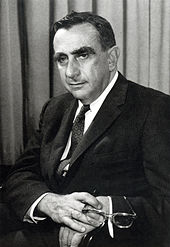
Fusion reactions do not create fission products, and thus contribute far less to the creation of nuclear fallout than fission reactions, but because all thermonuclear weapons contain at least one fission stage, and many high-yield thermonuclear devices have a final fission stage, thermonuclear weapons can generate at least as much nuclear fallout as fission-only weapons. Furthermore, high yield thermonuclear explosions (most dangerously ground bursts) have the force to lift radioactive debris upwards past the tropopause into the stratosphere, where the calm non-turbulent winds permit the debris to travel great distances from the burst, eventually settling and unpredictably contaminating areas far removed from the target of the explosion.
Other types
There are other types of nuclear weapons as well. For example, a
The detonation of any nuclear weapon is accompanied by a blast of neutron radiation. Surrounding a nuclear weapon with suitable materials (such as cobalt or gold) creates a weapon known as a salted bomb. This device can produce exceptionally large quantities of long-lived radioactive contamination. It has been conjectured that such a device could serve as a "doomsday weapon" because such a large quantity of radioactivities with half-lives of decades, lifted into the stratosphere where winds would distribute it around the globe, would make all life on the planet extinct.
In connection with the Strategic Defense Initiative, research into the nuclear pumped laser was conducted under the DOD program Project Excalibur but this did not result in a working weapon. The concept involves the tapping of the energy of an exploding nuclear bomb to power a single-shot laser that is directed at a distant target.
During the Starfish Prime high-altitude nuclear test in 1962, an unexpected effect was produced which is called a nuclear electromagnetic pulse. This is an intense flash of electromagnetic energy produced by a rain of high-energy electrons which in turn are produced by a nuclear bomb's gamma rays. This flash of energy can permanently destroy or disrupt electronic equipment if insufficiently shielded. It has been proposed to use this effect to disable an enemy's military and civilian infrastructure as an adjunct to other nuclear or conventional military operations. By itself it could as well be useful to terrorists for crippling a nation's economic electronics-based infrastructure. Because the effect is most effectively produced by high altitude nuclear detonations (by military weapons delivered by air, though ground bursts also produce EMP effects over a localized area), it can produce damage to electronics over a wide, even continental, geographical area.[20]
Research has been done into the possibility of pure fusion bombs: nuclear weapons that consist of fusion reactions without requiring a fission bomb to initiate them. Such a device might provide a simpler path to thermonuclear weapons than one that required the development of fission weapons first, and pure fusion weapons would create significantly less nuclear fallout than other thermonuclear weapons because they would not disperse fission products. In 1998, the United States Department of Energy divulged that the United States had, "...made a substantial investment" in the past to develop pure fusion weapons, but that, "The U.S. does not have and is not developing a pure fusion weapon", and that, "No credible design for a pure fusion weapon resulted from the DOE investment".[21]
Most variation in
Tactical nuclear weapons

Some nuclear weapons are designed for special purposes; most of these are for non-strategic (decisively war-winning) purposes and are referred to as tactical nuclear weapons.
The neutron bomb purportedly conceived by Sam Cohen is a thermonuclear weapon that yields a relatively small explosion but a relatively large amount of neutron radiation. Such a weapon could, according to tacticians, be used to cause massive biological casualties while leaving inanimate infrastructure mostly intact and creating minimal fallout. Because high energy neutrons are capable of penetrating dense matter, such as tank armor, neutron warheads were procured in the 1980s (though not deployed in Europe) for use as tactical payloads for US Army artillery shells (200 mm W79 and 155 mm W82) and short range missile forces. Soviet authorities announced similar intentions for neutron warhead deployment in Europe; indeed, they claimed to have originally invented the neutron bomb, but their deployment on USSR tactical nuclear forces is unverifiable.[citation needed]
A type of nuclear explosive most suitable for use by ground special forces was the Special Atomic Demolition Munition, or SADM, sometimes popularly known as a suitcase nuke. This is a nuclear bomb that is man-portable, or at least truck-portable, and though of a relatively small yield (one or two kilotons) is sufficient to destroy important tactical targets such as bridges, dams, tunnels, important military or commercial installations, etc. either behind enemy lines or pre-emptively on friendly territory soon to be overtaken by invading enemy forces. These weapons require plutonium fuel and are particularly "dirty". They also demand especially stringent security precautions in their storage and deployment.[citation needed]
Small "tactical" nuclear weapons were deployed for use as antiaircraft weapons. Examples include the USAF AIR-2 Genie, the AIM-26 Falcon and US Army Nike Hercules. Missile interceptors such as the Sprint and the Spartan also used small nuclear warheads (optimized to produce neutron or X-ray flux) but were for use against enemy strategic warheads.[citation needed]
Other small, or tactical, nuclear weapons were deployed by naval forces for use primarily as
Weapons delivery
The system used to deliver a nuclear weapon to its target is an important factor affecting both nuclear weapon design and nuclear strategy. The design, development, and maintenance of delivery systems are among the most expensive parts of a nuclear weapons program; they account, for example, for 57% of the financial resources spent by the United States on nuclear weapons projects since 1940.[28]
The simplest method for delivering a nuclear weapon is a
Preferable from a strategic point of view is a nuclear weapon mounted on a missile, which can use a ballistic trajectory to deliver the warhead over the horizon. Although even short-range missiles allow for a faster and less vulnerable attack, the development of long-range intercontinental ballistic missiles (ICBMs) and submarine-launched ballistic missiles (SLBMs) has given some nations the ability to plausibly deliver missiles anywhere on the globe with a high likelihood of success.
More advanced systems, such as multiple independently targetable reentry vehicles (MIRVs), can launch multiple warheads at different targets from one missile, reducing the chance of a successful missile defense. Today, missiles are most common among systems designed for delivery of nuclear weapons. Making a warhead small enough to fit onto a missile, though, can be difficult.[11]
Nuclear strategy
Nuclear warfare strategy is a set of policies that deal with preventing or fighting a nuclear war. The policy of trying to prevent an attack by a nuclear weapon from another country by threatening nuclear retaliation is known as the strategy of
Different forms of
Weapons designed to threaten large populations or to deter attacks are known as
Critics of nuclear war strategy often suggest that a nuclear war between two nations would result in mutual annihilation. From this point of view, the significance of nuclear weapons is to deter war because any nuclear war would escalate out of mutual distrust and fear, resulting in
Critics from the peace movement and within the military establishment[
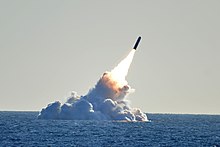
Another
The threat of potentially suicidal terrorists possessing nuclear weapons (a form of
Robert Gallucci argues that although traditional deterrence is not an effective approach toward terrorist groups bent on causing a nuclear catastrophe, Gallucci believes that "the United States should instead consider a policy of expanded deterrence, which focuses not solely on the would-be nuclear terrorists but on those states that may deliberately transfer or inadvertently leak nuclear weapons and materials to them. By threatening retaliation against those states, the United States may be able to deter that which it cannot physically prevent.".[38]
Graham Allison makes a similar case, arguing that the key to expanded deterrence is coming up with ways of tracing nuclear material to the country that forged the fissile material. "After a nuclear bomb detonates, nuclear forensics cops would collect debris samples and send them to a laboratory for radiological analysis. By identifying unique attributes of the fissile material, including its impurities and contaminants, one could trace the path back to its origin."[39] The process is analogous to identifying a criminal by fingerprints. "The goal would be twofold: first, to deter leaders of nuclear states from selling weapons to terrorists by holding them accountable for any use of their weapons; second, to give leaders every incentive to tightly secure their nuclear weapons and materials."[39]
According to the Pentagon's June 2019 "Doctrine for Joint Nuclear Operations" of the Joint Chiefs of Staffs website Publication, "Integration of nuclear weapons employment with conventional and special operations forces is essential to the success of any mission or operation."[40][41]
Governance, control, and law
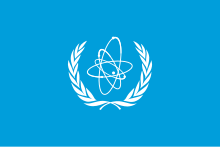
Because they are weapons of mass destruction, the proliferation and possible use of nuclear weapons are important issues in international relations and diplomacy. In most countries, the use of nuclear force can only be authorized by the head of government or head of state.[c] Despite controls and regulations governing nuclear weapons, there is an inherent danger of "accidents, mistakes, false alarms, blackmail, theft, and sabotage".[42]
In the late 1940s, lack of mutual trust prevented the United States and the Soviet Union from making progress on arms control agreements. The Russell–Einstein Manifesto was issued in London on July 9, 1955, by Bertrand Russell in the midst of the Cold War. It highlighted the dangers posed by nuclear weapons and called for world leaders to seek peaceful resolutions to international conflict. The signatories included eleven pre-eminent intellectuals and scientists, including Albert Einstein, who signed it just days before his death on April 18, 1955. A few days after the release, philanthropist Cyrus S. Eaton offered to sponsor a conference—called for in the manifesto—in Pugwash, Nova Scotia, Eaton's birthplace. This conference was to be the first of the Pugwash Conferences on Science and World Affairs, held in July 1957.
By the 1960s, steps were taken to limit both the proliferation of nuclear weapons to other countries and the environmental effects of

In 1957, the International Atomic Energy Agency (IAEA) was established under the mandate of the United Nations to encourage development of peaceful applications of nuclear technology, provide international safeguards against its misuse, and facilitate the application of safety measures in its use. In 1996, many nations signed the Comprehensive Nuclear-Test-Ban Treaty,[43] which prohibits all testing of nuclear weapons. A testing ban imposes a significant hindrance to nuclear arms development by any complying country.[44] The Treaty requires the ratification by 44 specific states before it can go into force; as of 2012[update], the ratification of eight of these states is still required.[43]
Additional treaties and agreements have governed nuclear weapons stockpiles between the countries with the two largest stockpiles, the United States and the Soviet Union, and later between the United States and Russia. These include treaties such as
Nuclear weapons have also been opposed by agreements between countries. Many nations have been declared
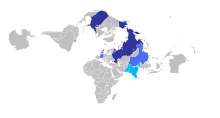
In 1996, the
Additionally, there have been other, specific actions meant to discourage countries from developing nuclear arms. In the wake of the tests by India and Pakistan in 1998, economic sanctions were (temporarily) levied against both countries, though neither were signatories with the Nuclear Non-Proliferation Treaty. One of the stated
In 2013, Mark Diesendorf said that governments of France, India, North Korea, Pakistan, UK, and South Africa have used nuclear power or research reactors to assist nuclear weapons development or to contribute to their supplies of nuclear explosives from military reactors.[47]
In 2017, 122 countries mainly in the
The
Disarmament
Nuclear disarmament refers to both the act of reducing or eliminating nuclear weapons and to the end state of a nuclear-free world, in which nuclear weapons are eliminated.
Beginning with the 1963
Only one country—South Africa—has ever fully renounced nuclear weapons they had independently developed. The former Soviet republics of
Proponents of nuclear disarmament say that it would lessen the probability of nuclear war, especially accidentally. Critics of nuclear disarmament say that it would undermine the present

In January 1986, Soviet leader Mikhail Gorbachev publicly proposed a three-stage program for abolishing the world's nuclear weapons by the end of the 20th century.[54] In the years after the end of the Cold War, there have been numerous campaigns to urge the abolition of nuclear weapons, such as that organized by the Global Zero movement, and the goal of a "world without nuclear weapons" was advocated by United States President Barack Obama in an April 2009 speech in Prague.[55] A CNN poll from April 2010 indicated that the American public was nearly evenly split on the issue.[56]
Some analysts have argued that nuclear weapons have made the world relatively safer, with peace through deterrence and through the stability–instability paradox, including in south Asia.[57][58] Kenneth Waltz has argued that nuclear weapons have helped keep an uneasy peace, and further nuclear weapon proliferation might even help avoid the large scale conventional wars that were so common before their invention at the end of World War II.[34] But former Secretary Henry Kissinger says there is a new danger, which cannot be addressed by deterrence: "The classical notion of deterrence was that there was some consequences before which aggressors and evildoers would recoil. In a world of suicide bombers, that calculation doesn't operate in any comparable way".[59] George Shultz has said, "If you think of the people who are doing suicide attacks, and people like that get a nuclear weapon, they are almost by definition not deterrable".[60]
As of early 2019, more than 90% of world's 13,865 nuclear weapons were owned by Russia and the United States.[61][62]
United Nations
The UN Office for Disarmament Affairs (UNODA) is a department of the
Its goal is to promote nuclear disarmament and
Controversy
Ethics

Even before the first nuclear weapons had been developed, scientists involved with the Manhattan Project were divided over the use of the weapon. The role of the two atomic bombings of the country in Japan's surrender and the U.S.'s ethical justification for them has been the subject of scholarly and popular debate for decades. The question of whether nations should have nuclear weapons, or test them, has been continually and nearly universally controversial.[64]
Notable nuclear weapons accidents
- August 21, 1945: While conducting experiments on a plutonium-gallium core at Los Alamos National Laboratory, physicist Harry Daghlian received a lethal dose of radiation when an error caused it to enter prompt criticality. He died 25 days later, on September 15, 1945, from radiation poisoning.[65]
- May 21, 1946: While conducting further experiments on the same core at Los Alamos National Laboratory, physicist Louis Slotin accidentally caused the core to become briefly supercritical. He received a lethal dose of gamma and neutron radiation, and died nine days later on May 30, 1946. After the death of Daghlian and Slotin, the mass became known as the "demon core". It was ultimately used to construct a bomb for use on the Nevada Test Range.[66]
- February 13, 1950: a Broken Arrow"—an accident involving a nuclear weapon, but which does not present a risk of war. Experts believe that up to 50 nuclear weapons were lost during the Cold War.[67]
- May 22, 1957: a 42,000-pound (19,000 kg) Mark-17 hydrogen bomb accidentally fell from a bomber near Albuquerque, New Mexico. The detonation of the device's conventional explosives destroyed it on impact and formed a crater 25 feet (7.6 m) in diameter on land owned by the University of New Mexico. According to a researcher at the Natural Resources Defense Council, it was one of the most powerful bombs made to date.[68]
- June 7, 1960: the BOMARC Missile Accident Sitein New Jersey.
- January 24, 1961: the 1961 Goldsboro B-52 crash occurred near Goldsboro, North Carolina. A Boeing B-52 Stratofortress carrying two Mark 39 nuclear bombs broke up in mid-air, dropping its nuclear payload in the process.[69]
- 1965 Philippine Sea A-4 crash, where a Skyhawk attack aircraft with a nuclear weapon fell into the sea.[70] The pilot, the aircraft, and the B43 nuclear bomb were never recovered.[71] It was not until 1989 that the Pentagon revealed the loss of the one-megaton bomb.[72]
- January 17, 1966: the hydrogen bombs the B-52G carried,[74] three were found on land near Almería, Spain. The non-nuclear explosives in two of the weapons detonated upon impact with the ground, resulting in the contamination of a 2-square-kilometer (490-acre) (0.78 square mile) area by radioactive plutonium. The fourth, which fell into the Mediterranean Sea, was recovered intact after a 21⁄2-month-long search.[75]
- January 21, 1968: the hydrogen bombs when a cabin fire forced the crew to abandon the aircraft. Six crew members ejected safely, but one who did not have an ejection seat was killed while trying to bail out. The bomber crashed onto sea ice in Greenland, causing the nuclear payload to rupture and disperse, which resulted in widespread radioactive contamination.[76] One of the bombs remains lost.[77]
- September 18–19, 1980: the
Nuclear testing and fallout
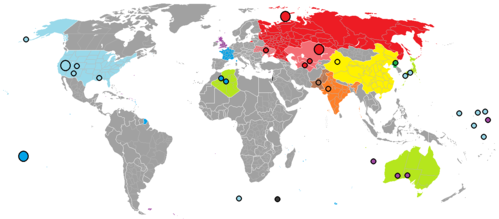

Over 500 atmospheric nuclear weapons tests were conducted at various sites around the world from 1945 to 1980.
As public awareness and concern mounted over the possible health hazards associated with exposure to the nuclear fallout, various studies were done to assess the extent of the hazard. A Centers for Disease Control and Prevention/ National Cancer Institute study claims that fallout from atmospheric nuclear tests would lead to perhaps 11,000 excess deaths among people alive during atmospheric testing in the United States from all forms of cancer, including leukemia, from 1951 to well into the 21st century.[82][83] As of March 2009[update], the U.S. is the only nation that compensates nuclear test victims. Since the Radiation Exposure Compensation Act of 1990, more than $1.38 billion in compensation has been approved. The money is going to people who took part in the tests, notably at the Nevada Test Site, and to others exposed to the radiation.[84][85]
In addition, leakage of byproducts of nuclear weapon production into groundwater has been an ongoing issue, particularly at the
Effects of nuclear explosions
Effects of nuclear explosions on human health

Some scientists estimate that a nuclear war with 100 Hiroshima-size nuclear explosions on cities could cost the lives of tens of millions of people from long-term climatic effects alone. The climatology hypothesis is that if each city firestorms, a great deal of soot could be thrown up into the atmosphere which could blanket the earth, cutting out sunlight for years on end, causing the disruption of food chains, in what is termed a nuclear winter.[87][88]
People near the Hiroshima explosion and who managed to survive the explosion subsequently suffered a variety of horrible medical effects. Some of these effects are still present to this day:[89]
- Initial stage—the first 1–9 weeks, in which are the greatest number of deaths, with 90% due to thermal injury or blast effects and 10% due to super-lethal radiation exposure.
- Intermediate stage—from 10 to 12 weeks. The deaths in this period are from LD50
- Late period—lasting from 13 to 20 weeks. This period has some improvement in survivors' condition.
- Delayed period—from 20+ weeks. Characterized by numerous complications, mostly related to healing of thermal and mechanical injuries, and if the individual was exposed to a few hundred to a thousand millisieverts of radiation, it is coupled with infertility, sub-fertility and blood disorders. Furthermore, ionizing radiation above a dose of around 50–100 millisievert exposure has been shown to statistically begin increasing one's chance of dying of cancer sometime in their lifetime over the normal unexposed rate of ~25%, in the long term, a heightened rate of cancer, proportional to the dose received, would begin to be observed after ~5+ years, with lesser problems such as eye cataractsand other more minor effects in other organs and tissue also being observed over the long term.
Staying indoors until after the most hazardous fallout
Effects of nuclear war
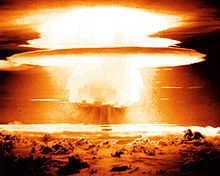
Nuclear war could yield unprecedented human
According to a peer-reviewed study published in the journal Nature Food in August 2022, a full-scale nuclear war between the U.S. and Russia would directly kill 360 million people and more than 5 billion people would die from starvation. More than 2 billion people could die from a smaller-scale nuclear war between India and Pakistan.[94][98][99]
Public opposition

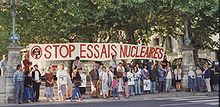
Peace movements emerged in Japan and in 1954 they converged to form a unified "Japan Council against Atomic and Hydrogen Bombs." Japanese opposition to nuclear weapons tests in the Pacific Ocean was widespread, and "an estimated 35 million signatures were collected on petitions calling for bans on nuclear weapons".[100]
In the United Kingdom, the first Aldermaston March organised by the Campaign for Nuclear Disarmament(CND) took place at Easter 1958, when, according to the CND, several thousand people marched for four days from Trafalgar Square, London, to the Atomic Weapons Research Establishment close to Aldermaston in Berkshire, England, to demonstrate their opposition to nuclear weapons.[101][102] The Aldermaston marches continued into the late 1960s when tens of thousands of people took part in the four-day marches.[100]
In 1959, a letter in the Bulletin of the Atomic Scientists was the start of a successful campaign to stop the Atomic Energy Commission dumping radioactive waste in the sea 19 kilometres from Boston.[103] In 1962, Linus Pauling won the Nobel Peace Prize for his work to stop the atmospheric testing of nuclear weapons, and the "Ban the Bomb" movement spread.[64]
In 1963, many countries ratified the
Costs and technology spin-offs
According to an audit by the
Non-weapons uses
Peaceful nuclear explosions are nuclear explosions conducted for non-military purposes, such as activities related to economic development including the creation of canals. During the 1960s and 1970s, both the United States and the Soviet Union conducted a number of PNEs. Six of the explosions by the Soviet Union are considered to have been of an applied nature, not just tests.
The United States and the Soviet Union later halted their programs. Definitions and limits are covered in the Peaceful Nuclear Explosions Treaty of 1976.[108][109] The stalled Comprehensive Nuclear-Test-Ban Treaty of 1996 would prohibit all nuclear explosions, regardless of whether they are for peaceful purposes or not.[110]
History of development

In the first decades of the 20th century,
In Paris in 1934,
In December 1938, Otto Hahn and Fritz Strassmann reported that they had detected the element barium after bombarding uranium with neutrons. Lise Meitner and Otto Robert Frisch correctly interpreted these results as being due to the splitting of the uranium atom. Frisch confirmed this experimentally on January 13, 1939.[112] They gave the process the name "fission" because of its similarity to the splitting of a cell into two new cells. Even before it was published, news of Meitner's and Frisch's interpretation crossed the Atlantic.[113] In their second publication on nuclear fission in February 1939, Hahn and Strassmann predicted the existence and liberation of additional neutrons during the fission process, opening up the possibility of a nuclear chain reaction.
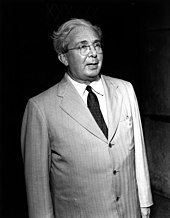
After learning about the German fission in 1939, Leo Szilard concluded that uranium would be the element which can realize his 1933 idea about nuclear chain reaction.[114]
Uranium appears in nature primarily in two isotopes:
By the start of the war in September 1939, many scientists likely to be persecuted by the Nazis had already escaped. Physicists on both sides were well aware of the possibility of utilizing nuclear fission as a weapon, but no one was quite sure how it could be engineered. In August 1939, concerned that Germany might have
Roosevelt responded by setting up the
Organized research first began in Britain and Canada as part of the
See also
- Cobalt bomb
- Cosmic bomb (phrase)
- Cuban Missile Crisis
- Dirty bomb
- List of global issues
- List of nuclear weapons
- List of states with nuclear weapons
- Nth Country Experiment
- Nuclear blackout
- Nuclear bunker buster
- Nuclear weapons of the United Kingdom
- Nuclear weapons in popular culture
- Nuclear weapons of the United States
- OPANAL (Agency for the Prohibition of Nuclear Weapons in Latin America and the Caribbean)
- Three Non-Nuclear Principles of Japan
References
Notes
- Explanatory Notes
- ^ also known as an atom bomb, atomic bomb, nuclear bomb, or nuclear warhead, and colloquially as an A-bomb or nuke
- ^ See also Mordechai Vanunu
- ^ In the United States, the President and the Secretary of Defense, acting as the National Command Authority, must jointly authorize the use of nuclear weapons.
- Citations
- ^ "Atomic Power for War and Peace". Popular Mechanics. Hearst Magazines. October 1945. pp. 18–19.
- ^ Sublette, Carey (June 12, 2020). "Complete List of All U.S. Nuclear Weapons". Nuclear weapon archive. Retrieved March 18, 2021.
- ^ "The U S Army Air Forces in World War II". Air Force Historical Support Division. Retrieved November 27, 2023.[permanent dead link]
- ^ "Frequently Asked Questions #1". Radiation Effects Research Foundation. Archived from the original on September 19, 2007. Retrieved September 18, 2007.
total number of deaths is not known precisely ... acute (within two to four months) deaths ... Hiroshima ... 90,000–166,000 ... Nagasaki ... 60,000–80,000
- ^ "Federation of American Scientists: Status of World Nuclear Forces". Fas.org. Archived from the original on January 2, 2013. Retrieved December 29, 2012.
- ^ "Nuclear Weapons – Israel". Fas.org. January 8, 2007. Archived from the original on December 7, 2010. Retrieved December 15, 2010.
- ^ Executive release. "South African nuclear bomb". Nuclear Threat Initiatives. Nuclear Threat Initiatives, South Africa (NTI South Africa). Archived from the original on September 28, 2012. Retrieved March 13, 2012.
- ^ Ian Lowe, "Three minutes to midnight", Australasian Science, March 2016, p. 49.
- ^ Jungk 1958, p. 201.
- from the original on March 31, 2017.
- ^ ISBN 978-0-9791915-0-3(2nd Ed.)
- ^ Albright, David; Kramer, Kimberly (August 22, 2005). "Neptunium 237 and Americium: World Inventories and Proliferation Concerns" (PDF). Institute for Science and International Security. Archived (PDF) from the original on January 3, 2012. Retrieved October 13, 2011.
- ^ Carey Sublette, Nuclear Weapons Frequently Asked Questions: 4.5.2 "Dirty" and "Clean" Weapons Archived March 3, 2016, at the Wayback Machine, accessed May 10, 2011.
- ^ On India's alleged hydrogen bomb test, see Carey Sublette, What Are the Real Yields of India's Test? Archived September 27, 2011, at the Wayback Machine.
- ^ McKirdy, Euan (January 6, 2016). "North Korea announces it conducted nuclear test". CNN. Archived from the original on January 7, 2016. Retrieved January 7, 2016.
- ^ "Nuclear Testing and Comprehensive Test Ban Treaty (CTBT) Timeline". Arms control association. Archived from the original on April 21, 2020.
- ^ Sublette, Carey. "The Nuclear Weapon Archive". Archived from the original on March 1, 2007. Retrieved March 7, 2007.
- ^ Simha, Rakesh Krishnan (January 5, 2016). "Nuclear overkill: The quest for the 10 gigaton bomb". Russia Beyond. Archived from the original on November 29, 2023. Retrieved October 8, 2023.
- ^ Wellerstein, Alex (October 29, 2021). "The untold story of the world's biggest nuclear bomb". Bulletin of the Atomic Scientists. Archived from the original on August 27, 2023. Retrieved October 8, 2023.
- ^ "Why the U.S. once set off a nuclear bomb in space". Premium. July 15, 2021. Archived from the original on November 29, 2023. Retrieved November 27, 2023.
- ^ U.S. Department of Energy, Restricted Data Declassification Decisions, 1946 to the Present (RDD-8) Archived September 24, 2015, at the Wayback Machine (January 1, 2002), accessed November 20, 2011.
- ^ arXiv:physics/0510071.
- ^ "Details on antimatter triggered fusion bombs". NextBigFuture.com. September 22, 2015. Archived from the original on April 22, 2017.
- ^ "Page discussing the possibility of using antimatter as a trigger for a thermonuclear explosion". Cui.unige.ch. Archived from the original on April 24, 2013. Retrieved May 30, 2013.
- arXiv:physics/0507114.
- ^ Keay Davidson; Chronicle Science Writer (October 4, 2004). "Air Force pursuing antimatter weapons: Program was touted publicly, then came official gag order". Sfgate.com. Archived from the original on June 9, 2012. Retrieved May 30, 2013.
- ^ "Fourth Generation Nuclear Weapons". Archived from the original on March 23, 2016. Retrieved October 24, 2014.
- ^ Stephen I. Schwartz, ed., Atomic Audit: The Costs and Consequences of U.S. Nuclear Weapons Since 1940. Washington, D.C.: Brookings Institution Press, 1998. See also Estimated Minimum Incurred Costs of U.S. Nuclear Weapons Programs, 1940–1996, an excerpt from the book. Archived November 21, 2008, at the Wayback Machine
- ^ Mehta, Aaron (October 27, 2023). "US to introduce new nuclear gravity bomb design: B61-13". Breaking Defense. Archived from the original on December 17, 2023. Retrieved November 27, 2023.
- ISBN 978-1-136-28624-7. Archivedfrom the original on March 31, 2017.
- ISBN 978-0-19-285373-8.
- (PDF) from the original on May 1, 2013. See page 116
- ^ Kenneth Waltz, "More May Be Better", in Scott Sagan and Kenneth Waltz, eds., The Spread of Nuclear Weapons (New York: Norton, 1995).
- ^ a b Kenneth Waltz, "The Spread of Nuclear Weapons: More May Better", Archived December 1, 2010, at the Wayback Machine Adelphi Papers, no. 171 (London: International Institute for Strategic Studies, 1981).
- ^ "Should We Let the Bomb Spread? Edited by Mr. Henry D. Sokolski. Strategic studies institute. November 2016". Archived from the original on November 23, 2016.
- ^ See, for example: Feldman, Noah. "Islam, Terror and the Second Nuclear Age Archived February 19, 2016, at the Wayback Machine", New York Times Magazine (October 29, 2006).
- ^ Daniel Plesch & Stephen Young, "Senseless policy", Bulletin of the Atomic Scientists Archived September 19, 2015, at the Wayback Machine, November/December 1998, page 4. Fetched from URL on April 18, 2011.
- S2CID 68857650.
- ^ a b Allison, Graham (March 13, 2009). "How to Keep the Bomb From Terrorist s". Newsweek. Archived from the original on May 13, 2013. Retrieved January 28, 2013.
- ^ "The Pentagon Revealed Its Nuclear War Strategy and It's Terrifying". Vice. June 21, 2019. Archived from the original on December 7, 2019. Retrieved October 9, 2019.
- ^ "Nuclear weapons: experts alarmed by new Pentagon 'war-fighting' doctrine". The Guardian. June 19, 2019. Archived from the original on June 19, 2019. Retrieved October 9, 2019.
- ^ Eric Schlosser, Today's nuclear dilemma Archived January 1, 2016, at the Wayback Machine, Bulletin of the Atomic Scientists, November/December 2015, vol. 71 no. 6, 11–17.
- ^ a b Preparatory Commission for the Comprehensive Nuclear-Test-Ban Treaty Organization (2010). "Status of Signature and Ratification Archived April 6, 2011, at the Wayback Machine". Accessed May 27, 2010. Of the "Annex 2" states whose ratification of the CTBT is required before it enters into force, China, Egypt, Iran, Israel, and the United States have signed but not ratified the Treaty. India, North Korea, and Pakistan have not signed the Treaty.
- ^ Richelson, Jeffrey. Spying on the bomb: American nuclear intelligence from Nazi Germany to Iran and North Korea. New York: Norton, 2006.
- ^ The Presidential Nuclear Initiatives (PNIs) on Tactical Nuclear Weapons At a Glance Archived January 19, 2011, at the Wayback Machine, Fact Sheet, Arms Control Association.
- ^ Nuclear weapons and international humanitarian law Archived April 21, 2010, at the Wayback Machine International Committee of the Red Cross
- ^ Mark Diesendorf (2013). "Book review: Contesting the future of nuclear power" (PDF). Energy Policy. Archived from the original (PDF) on September 27, 2013. Retrieved July 9, 2013.[dubious ]
- ^ "History of the TPNW". ICAN. Archived from the original on June 5, 2023. Retrieved June 5, 2023.
- ^ Koran, Laura (January 25, 2018). "'Doomsday clock' ticks closer to apocalyptic midnight". CNN. Archived from the original on November 3, 2019. Retrieved November 3, 2019.
- ^ Spinazze, Gayle (January 24, 2023). "PRESS RELEASE: Doomsday Clock set at 90 seconds to midnight". Bulletin of the Atomic Scientists. Archived from the original on January 24, 2023. Retrieved June 5, 2023.
- ^ Gusterson, Hugh, "Finding Article VI Archived September 17, 2008, at the Wayback Machine" Bulletin of the Atomic Scientists (January 8, 2007).
- ^ Jim Hoagland (October 6, 2011). "Nuclear energy after Fukushima". The Washington Post. Archived from the original on October 1, 2013.
- ^ Lawrence M. Krauss. The Doomsday Clock Still Ticks, Scientific American, January 2010, p. 26.
- ISBN 978-1-4711-4796-8.
- ^ Graham, Nick (April 5, 2009). "Obama Prague Speech On Nuclear Weapons". Huffingtonpost.com. Archived from the original on May 9, 2013. Retrieved May 30, 2013.
- ^ "CNN Poll: Public divided on eliminating all nuclear weapons". Politicalticker.blogs.cnn.com. April 12, 2010. Archived from the original on July 21, 2013. Retrieved May 30, 2013.
- ^ Krepon, Michael. "The Stability-Instability Paradox, Misperception, and Escalation Control in South Asia" (PDF). Stimson. Archived from the original (PDF) on September 24, 2015. Retrieved November 20, 2015.
- ^ "Michael Krepon • The Stability-Instability Paradox". Archived from the original on January 12, 2015. Retrieved October 24, 2014.
- ^ Ben Goddard (January 27, 2010). "Cold Warriors say no nukes". The Hill. Archived from the original on February 13, 2014.
- ^ Hugh Gusterson (March 30, 2012). "The new abolitionists". Bulletin of the Atomic Scientists. Archived from the original on February 17, 2014. Retrieved February 2, 2014.
- ^ Reichmann, Kelsey (June 16, 2019). "Here's how many nuclear warheads exist, and which countries own them". Defense News. Archived from the original on July 28, 2020. Retrieved July 23, 2019.
- ^ "Global Nuclear Arsenal Declines, But Future Cuts Uncertain Amid U.S.-Russia Tensions". Radio Free Europe/Radio Liberty (RFE/RL). June 17, 2019. Archived from the original on July 2, 2019. Retrieved July 23, 2019.
- ^ Kofi Annan (July 14, 1997). "Renewing the United Nations: A Program for Reform". United Nations. A/51/950. Archived from the original on March 18, 2017. Retrieved March 17, 2017.
- ^ a b Jerry Brown and Rinaldo Brutoco (1997). Profiles in Power: The Anti-nuclear Movement and the Dawn of the Solar Age, Twayne Publishers, pp. 191–192.
- ^ "Atomic Accidents – Nuclear Museum". ahf.nuclearmuseum.org/. Archived from the original on October 12, 2023. Retrieved November 28, 2023.
- ^ "The Nuclear 'Demon Core' That Killed Two Scientists". April 23, 2018. Archived from the original on April 24, 2018. Retrieved April 23, 2018.
- ^ "The Cold War's Missing Atom Bombs". Der Spiegel. November 14, 2008. Archived from the original on June 27, 2019. Retrieved August 20, 2019.
- ^ "Accident Revealed After 29 Years: H-Bomb Fell Near Albuquerque in 1957". Los Angeles Times. Associated Press. August 27, 1986. Archived from the original on September 10, 2014. Retrieved August 31, 2014.
- ^ Barry Schneider (May 1975). "Big Bangs from Little Bombs". Bulletin of the Atomic Scientists. p. 28. Retrieved July 13, 2009.
- ^ "Ticonderoga Cruise Reports". Archived from the original (Navy.mil weblist of Aug 2003 compilation from cruise reports) on September 7, 2004. Retrieved April 20, 2012.
The National Archives hold[s] deck logs for aircraft carriers for the Vietnam Conflict.
- ^ Broken Arrows Archived September 1, 2013, at the Wayback Machine at www.atomicarchive.com. Accessed August 24, 2007.
- ^ "U.S. Confirms '65 Loss of H-Bomb Near Japanese Islands". The Washington Post. Reuters. May 9, 1989. p. A–27.
- ^ Hayes, Ron (January 17, 2007). "H-bomb incident crippled pilot's career". Palm Beach Post. Archived from the original on June 16, 2011. Retrieved May 24, 2006.
- ISBN 978-0-89745-214-4.
- ^ Long, Tony (January 17, 2008). "Jan. 17, 1966: H-Bombs Rain Down on a Spanish Fishing Village". WIRED. Archived from the original on December 3, 2008. Retrieved February 16, 2008.
- ^ "The Cold War's Missing Atom Bombs". Der Spiegel. November 14, 2008. Archived from the original on June 27, 2019. Retrieved August 20, 2019.
- ^ "US left nuclear weapon under ice in Greenland". The Daily Telegraph. November 11, 2008. Archived from the original on January 10, 2022.
- ISBN 978-1-59420-227-8.
- ^ Christ, Mark K. "Titan II Missile Explosion". The Encyclopedia of Arkansas History & Culture. Arkansas Historic Preservation Program. Archived from the original on September 12, 2014. Retrieved August 31, 2014.
- ^ Stumpf, David K. (2000). Christ, Mark K.; Slater, Cathryn H. (eds.). "We Can Neither Confirm Nor Deny" Sentinels of History: Refelections on Arkansas Properties on the National Register of Historic Places. Fayetteville, Arkansas: University of Arkansas Press.
- ^ ISBN 978-0582902695.
- ^ "Report on the Health Consequences to the American Population from Nuclear Weapons Tests Conducted by the United States and Other Nations". CDC. Archived from the original on December 4, 2013. Retrieved December 7, 2013.
- PMID 25057651. Archived from the originalon September 7, 2014. Retrieved October 24, 2014.
- ^ "What governments offer to victims of nuclear tests". ABC News. Archived from the original on January 18, 2023. Retrieved October 24, 2014.
- ^ "Radiation Exposure Compensation System: Claims to Date Summary of Claims Received by 06/11/2009" (PDF). Archived (PDF) from the original on September 7, 2009.
- ^ Coghlan, Andy. "US nuclear dump is leaking toxic waste". New Scientist. Archived from the original on April 13, 2016. Retrieved March 12, 2016.
- ^ Philip Yam. Nuclear Exchange, Scientific American, June 2010, p. 24.
- ^ Alan Robock and Owen Brian Toon. Local Nuclear War, Global Suffering, Scientific American, January 2010, pp. 74–81.
- ^ "Hiroshima and Nagasaki: The Long Term Health Effects | K=1 Project". k1project.columbia.edu. Archived from the original on June 20, 2017. Retrieved September 7, 2017.
- ^ "Decay Information". Fallout Radiation.com. Archived from the original on August 31, 2011.
7 hour rule: At 7 hours after detonation the fission product activity will have decreased to about 1/10 (10%) of its amount at 1 hour. At about 2 days (49 hours-7X7) the activity will have decreased to 1% of the 1-hour value
- ^ "Nuclear Warfare" (PDF). p. 22. Archived from the original (PDF) on November 26, 2013.
- ^ "Public Health Assessment – Iodine-131 Releases" (PDF). Agency for Toxic Substances and Disease Registry. U.S. Center for Disease Control. March 2008. Archived (PDF) from the original on May 11, 2016. Retrieved May 21, 2016.
- ^ Meyer, Robinson (April 29, 2016). "You're More Likely to Die in a Human Extinction Event Than a Car Crash". The Atlantic. Archived from the original on May 1, 2016. Retrieved April 19, 2020.
- ^ a b Diaz-Maurin, François (October 20, 2022). "Nowhere to hide: How a nuclear war would kill you — and almost everyone else". Bulletin of the Atomic Scientists. Archived from the original on October 26, 2022. Retrieved October 26, 2022.
- from the original on April 4, 2020. Retrieved October 25, 2014.
- S2CID 144553194.
- ^ Helfand, Ira. "Nuclear Famine: Two Billion People at Risk?" (PDF). International Physicians for the Prevention of Nuclear War. Archived (PDF) from the original on April 5, 2016. Retrieved February 13, 2016.
- ^ "World Nuclear war between the U.S. and Russia would kill more than 5 billion people – just from starvation, study finds". CBS News. August 16, 2022. Archived from the original on October 26, 2022. Retrieved October 26, 2022.
- S2CID 251601831.
- ^ a b Jim Falk (1982). Global Fission: The Battle Over Nuclear Power, Oxford University Press, pp. 96–97.
- ^ "A brief history of CND". Cnduk.org. Archived from the original on June 17, 2004. Retrieved May 30, 2013.
- Guardian Unlimited. London. April 5, 1958. Archivedfrom the original on October 8, 2006.
- ^ Jim Falk (1982). Global Fission: The Battle Over Nuclear Power, Oxford University Press, p. 93.
- ^ Jim Falk (1982). Global Fission: The Battle Over Nuclear Power, Oxford University Press, p. 98.
- ^ Spencer Weart, Nuclear Fear: A History of Images (Cambridge, Massachusetts: Harvard University Press, 1988), chapters 16 and 19.
- ^ 1634–1699: McCusker, J. J. (1997). How Much Is That in Real Money? A Historical Price Index for Use as a Deflator of Money Values in the Economy of the United States: Addenda et Corrigenda (PDF). American Antiquarian Society. 1700–1799: McCusker, J. J. (1992). How Much Is That in Real Money? A Historical Price Index for Use as a Deflator of Money Values in the Economy of the United States (PDF). American Antiquarian Society. 1800–present: Federal Reserve Bank of Minneapolis. "Consumer Price Index (estimate) 1800–". Retrieved February 29, 2024.
- ^ "Estimated Minimum Incurred Costs of U.S. Nuclear Weapons Programs, 1940–1996". Brookings Institution. Archived from the original on March 5, 2004. Retrieved November 20, 2015.
- ^ "Announcement of Treaty on Underground Nuclear Explosions Peaceful Purposes (PNE Treaty)" (PDF). Gerald R. Ford Museum and Library. May 28, 1976. Archived from the original (PDF) on March 5, 2016. Retrieved February 22, 2016.
- ^ Peters, Gerhard; Woolley, John T. "Gerald R. Ford: "Message to the Senate Transmitting United States-Soviet Treaty and Protocol on the Limitation of Underground Nuclear Explosions", July 29, 1976". The American Presidency Project. University of California – Santa Barbara. Archived from the original on March 3, 2016.
- ^ "Status of Signature and Ratification". ctbto dot org. CTBT Organization Preparatory Commission. Archived from the original on December 28, 2016. Retrieved December 29, 2016.
- ISBN 978-1-502-61949-5.
- ^ Rhodes 1986, pp. 263, 268.
- ^ Rhodes 1986, p. 268.
- ^ "Leo Szilard | Biographies". www.atomicarchive.com.
- ^ Rhodes 1986, pp. 305–312.
- ISBN 978-0-7914-6868-5.
- ISBN 978-1-137-22295-4.
- ISBN 978-0-786-74822-8.
Bibliography
- ISBN 0-671-74012-1
- DeVolpi, Alexander, Minkov, Vladimir E., Simonenko, Vadim A., and Stanford, George S. Nuclear Shadowboxing: Contemporary Threats from Cold War Weaponry. Fidlar Doubleday, 2004 (Two volumes, both accessible on Google Book Search) (Content of both volumes is now available in the 2009 trilogy by Alexander DeVolpi: Nuclear Insights: The Cold War Legacy)
- Glasstone, Samuel and Dolan, Philip J. The Effects of Nuclear Weapons (third edition). Washington, D.C.: U.S. Government Printing Office, 1977. Available online (PDF).
- NATO Handbook on the Medical Aspects of NBC Defensive Operations (Part I – Nuclear) Archived April 8, 2015, at the Wayback Machine. Departments of the Army, Navy, and Air Force: Washington, D.C., 1996
- Hansen, Chuck. U.S. Nuclear Weapons: The Secret History. Arlington, TX: Aerofax, 1988
- Hansen, Chuck, "Swords of Armageddon: U.S. nuclear weapons development since 1945 Archived December 30, 2016, at the ISBN 978-0-9791915-0-3(2nd Ed.)
- Holloway, David. Stalin and the Bomb. New Haven: Yale University Press, 1994. ISBN 0-300-06056-4
- The Manhattan Engineer District, "The Atomic Bombings of Hiroshima and Nagasaki Archived February 4, 2012, at the Wayback Machine" (1946)
- (in French) Jean-Hugues Oppel, Réveillez le président, Éditions Payot et rivages, 2007 (nuclear weaponsof France; the book also contains about ten chapters on true historical incidents involving nuclear weapons and strategy.
- Smyth, Henry DeWolf. Atomic Energy for Military Purposes. Archived April 21, 2017, at the Wayback Machine Princeton, NJ: Princeton University Press, 1945. (Smyth Report – the first declassified report by the US government on nuclear weapons)
- The Effects of Nuclear War. Office of Technology Assessment, May 1979.
- ISBN 0-684-82414-0
- Rhodes, Richard. ISBN 0-684-81378-5
- ISBN 978-0-8179-1845-3.
- ISBN 0-674-62836-5
- Weart, Spencer R. The Rise of Nuclear Fear. Cambridge, Massachusetts: Harvard University Press, 2012. ISBN 0-674-05233-1
Further reading
- Laura Grego and David Wright, "Broken Shield: Missiles designed to destroy incoming nuclear warheads fail frequently in tests and could increase global risk of mass destruction", Scientific American, vol. 320, no. no. 6 (June 2019), pp. 62–67. "Current U.S. missile defense plans are being driven largely by technology, politics and fear. Missile defenses will not allow us to escape our vulnerability to nuclear weapons. Instead large-scale developments will create barriers to taking real steps toward reducing nuclear risks—by blocking further cuts in nuclear arsenals and potentially spurring new deployments." (p. 67.)
- INF [Intermediate-Range Nuclear Forces] Treaty [of 1987] has escalated the arms race", The Nation, vol. 309, no. 6 (September 23, 2019), p. 4.
- U.S. Senator Sam Nunn write that "the old [strategic] equilibrium" between the United States and Russia has been "destabilized" by "clashing national interests, insufficient dialogue, eroding arms control structures, advanced missile systems, and new cyberweapons... Unless Washington and Moscow confront these problems now, a major international conflict or nuclear escalation is disturbingly plausible—perhaps even likely." (p. 161.)
- ISBN 9781608196708, 420 pp.), The New York Review of Books, vol. LXV, no. 1 (January 18, 2018), pp. 13–15.
- nuclear-weapon statesare obliged to work toward the elimination of nuclear weapons.
- Tom Stevenson, "A Tiny Sun" (review of Fred Kaplan, The Bomb: Presidents, Generals, and the Secret History of Nuclear War, Simon and Schuster, 2021, 384 pp.; and Keir A. Lieber and Daryl G. Press, The Myth of the Nuclear Revolution: Power Politics in the Atomic Age, Cornell, 2020, 180 pp.), London Review of Books, vol. 44, no. 4 (24 February 2022), pp. 29–32. "Nuclear strategists systematically underestimate the chances of nuclear accident... [T]here have been too many close calls for accidental use to be discounted." (p. 32.)
- David Wright and Cameron Tracy, "Over-hyped: Physics dictates that hypersonic weapons cannot live up to the grand promises made on their behalf", Scientific American, vol. 325, no. 2 (August 2021), pp. 64–71. "Failure to fully assess [the potential benefits and costs of hypersonic weapons] is a recipe for wasteful spending and increased global risk." (p. 71.)
External links
 Media related to Nuclear weapons at Wikimedia Commons
Media related to Nuclear weapons at Wikimedia Commons- Nuclear Weapon Archive from Carey Sublette: reliable source, has links to other sources and an informative FAQ.
- The Federation of American Scientists provide information on weapons of mass destruction, including nuclear weapons and their effects
- Alsos Digital Library for Nuclear Issues – contains resources related to nuclear weapons, including a historical and technical overview and searchable bibliography of web and print resources
- Video archive of US, Soviet, UK, Chinese and French Nuclear Weapon Testing at sonicbomb.com
- The National Museum of Nuclear Science & History (United States) – located in New Mexico; a Smithsonian Affiliate Museum
- Nuclear Emergency and Radiation Resources
- The Manhattan Project: Making the Atomic Bomb at AtomicArchive.com
- Los Alamos National Laboratory: History (U.S. nuclear history)
- Race for the Superbomb, PBS website on the history of the H-bomb
- Recordings of recollections of the victims of Hiroshima and Nagasaki
- The Woodrow Wilson Center's Nuclear Proliferation International History Project or NPIHP is a global network of individuals and institutions engaged in the study of international nuclear history through archival documents, oral history interviews and other empirical sources.
- NUKEMAP3D – a 3D nuclear weapons effects simulator powered by Google Maps.

